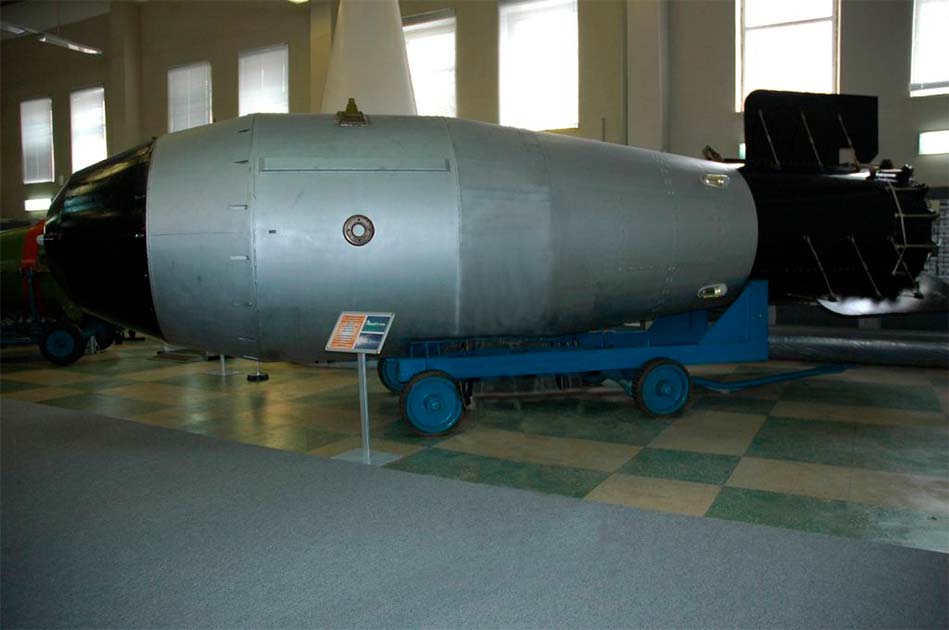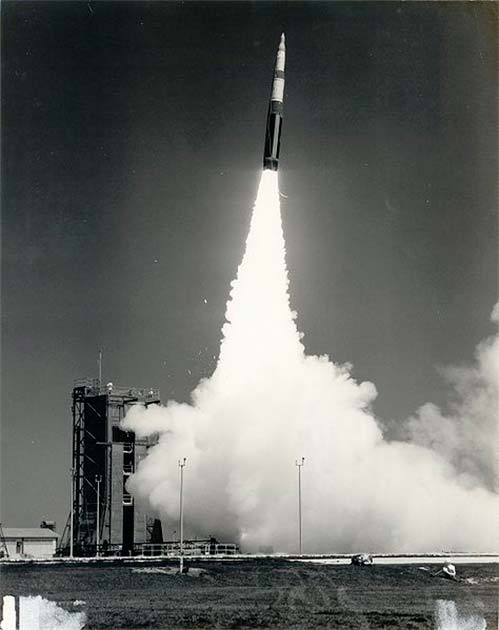Scientists across the world expressed real concerns at the first nuclear tests. Aside from the almost limitless destruction these weapons could cause, there were greater unknowns, not least the fear that explosions of this magnitude could literally set the atmosphere on fire.
These concerns came mainly from the west, and if there were similar doubts in the Soviet bloc, it has not been recorded. For the Soviets, it would seem, were taking things in another direction. Their ultimate weapon, the largest explosion mankind has ever caused, was called the Tsar Bomba.
The Tsar Bomba, literally the King of Bombs, was a show of force to the enemies of the Soviets. Developed during the height of the Cold War by the Soviet Union, its sheer magnitude shook the world.
With a yield surpassing 50 megatons of TNT, the Tsar Bomba left an indelible mark on the strategic landscape of the era. It may never have been used in combat, but the story of the Tsar Bomba is a chilling look into the reality of the arms race that shaped global politics, and the madness of the doctrine of Mutually Assured Destruction which shaped the Cold War.
King of Bombs
The Tsar Bomba was the Western nickname given to the Soviet’s behemoth RDS-220 (РДС-220) hydrogen bomb. When it was detonated on October 30, 1961, it was the largest nuclear device ever detonated and produced the most powerful man-made explosion in history.

The yield was that of 50 megatons of TNT, but it’s believed that theoretically, the bomb could have reached 100 megatons. Why didn’t the Soviets go that big? Well, firstly the level of nuclear fallout would have been immense, and secondly, the delivery plane would never have had time to flee to a safe distance.
The bomb weighed 27 metric tons (59,525 lbs) and was 8 meters (26 feet) in length and 2.1 meters (6.9 feet) wide. The bomb was dropped from a specially modified Tu-95V long-range bomber. The Tsar Bomba was so large that the plane’s bomb bay doors and fuselage fuel tanks had to be removed. The plane was also covered in reflective white paint to minimize thermal damage.
To give the plane time to get out of range the bomb was attached to a massive parachute, giving the plane time to get at least 30 miles (50 km) from the bomb before it went off. Despite all of this the crew were only given a 50/50 chance of survival.
- Secrets of the Polygon: The Soviet Nuclear Testing Grounds
- Castle Bravo and the Shrimp: When Nuclear Testing Goes Very Wrong
The bomb was detonated in the atmosphere over Mityushikha Bay Nuclear Testing Range in the northern Arctic Circle, detonating at 34,000 feet. The explosion it produced was around 1,570 times more powerful than the American bombs that had decimated Hiroshima and Nagasaki and were 10 times more powerful than the combined explosions of all the conventional weapons used during World War II.
The range of the bomb was mind-boggling. In Severny, an island 34 miles (54 km) from ground zero, every wooden and brick building was destroyed. Soviet districts 100 miles (161 km) away saw most of their wooden houses destroyed and brick and stone buildings were heavily damaged.

But it wasn’t just the shockwave. At a distance of 62 miles (100 km), the heat produced was strong enough to cause third-degree burns, and a witness at 170 miles (275 km) reported experiencing thermal effects, despite wearing goggles. The shockwave reportedly hit the Diksons settlement, 430 miles (690 km) away, and smashed windows as far out as 560 miles (900 km).
The area affected by the Tsar Bomba was truly staggering. To compare to a real world example, were the bomb to be detonated in Washington DC, the shockwave would hit New York, Philadelphia and Pittsburgh.
So, the physical damage it caused was immense. However, the nuclear fallout wasn’t as bad as one might expect. To minimize nuclear fallout the Soviets had modified the bomb with a lead tamper in the third and second stages of the detonation, which reduced the amount of nuclear fallout produced by the bomb.
MADness
The primary purpose behind the creation of the Tsar Bomba was to highlight the Soviet Union’s military might and demonstrate its nuclear capabilities to the world. The Soviet Union wanted to display its ability to produce a weapon with an unprecedented amount of destructive power.
By developing and detonating such a massive bomb, they aimed to deter potential adversaries and solidify their position as a superpower. It was never actually meant to be used as a practical weapon. It was merely proof of concept and a demonstration of the Soviet Union’s technological prowess and a means of asserting its dominance in the global arms race.
The Cold War had seen the rise of the MAD doctrine (Mutually Assured Destruction). It aimed to prevent full-scale nuclear war by creating a balance of power and ensuring that both sides would suffer catastrophic consequences if they initiated a nuclear attack.
The principle behind MAD was that if one side launched a nuclear attack, the other side would still have enough surviving nuclear forces to retaliate with overwhelming force, causing devastation to both sides. The Tsar Bomba’s massive yield showcased the Soviet Union’s capacity to respond with destructive force in the event of an attack, reinforcing the concept of mutually assured destruction.
So, while the Tsar Bomba may sound terrifying, it actually contributed to the overall balance of power during the Cold War and helped to ensure peace. The MAD strategy was based on the premise that the enormous destructive power possessed by both sides would act as a deterrent, preventing either side from launching a first strike and thereby avoiding a full-scale nuclear war. The existence of Tsar Bomba did just that.
That being said, there were repercussions. The Western response to the development and testing of the Tsar Bomba by the Soviet Union varied, but it generally intensified the arms race and heightened concerns about nuclear proliferation and the overall security situation.
The US and its Western allies, and especially the countries of NATO, accelerated their own nuclear weapons programs. Rather than focusing on the size of the explosion they began to focus on increasingly advanced delivery systems. This included the development of intercontinental ballistic missiles (ICBMs) capable of delivering nuclear warheads with greater accuracy and range.
It also led to an arms build-up. Western countries, especially the United States, invested heavily in expanding their nuclear stockpiles and improving the quality and sophistication of their own nuclear weapons.

Eventually, this led to diplomatic discussions on Arms Control as the world at large became increasingly nervous. Various agreements were eventually signed aimed at limiting the spread of nuclear weapons, reducing stockpiles, and promoting arms control measures. The Strategic Arms Limitation Talks (SALT) and the Anti-Ballistic Missile (ABM) Treaty were signed between the United States and the Soviet Union in the 1970s.
The Limits of Brinkmanship
The Tsar Bomba is a testament to the terrifying potential of nuclear weapons and the extremes to which nations were willing to push the boundaries of destructive power. Its development and detonation during the Cold War era underscored the arms race between the United States and the Soviet Union, intensifying fears of a cataclysmic nuclear conflict.
While the Tsar Bomba’s test was conducted in a remote location, its colossal yield served as a haunting reminder of the devastating consequences that could be unleashed upon humanity. Ultimately, the legacy of the Tsar Bomba serves as a solemn reminder of the imperative to prevent the use of such weapons and pursue peaceful resolutions to global conflicts.
Top Image: The Tsar Bomba was the largest manmade explosion in history. Source: Pixel Matrix / Adobe Stock.